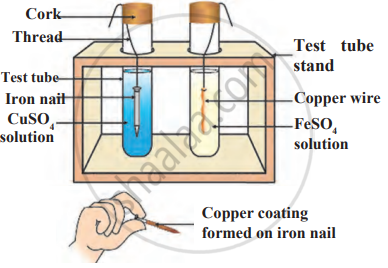Advertisements
Advertisements
Question
With reference to Acid explain with a suitable example of how the reactivity of the metals could be differentiated.
Solution
Action of metals with acids: As reactivity decreases from top to bottom in metal activity series.
K and Na react with dil. HC1 and dil. H2SO4 explosively to produce H2↑
\[\ce{2Na + 2HCl->2NaCl + H2}\]
Ca, Mg, Al, Zn, and iron react less vigorously with decreasing vigour with dil. H2SO4 or dil. HC1 to produce H2↑
\[\ce{Ca + H2SO->CaSO4 + H2}\]
Metals below hydrogen do not react with dil. acid and do not displace H2 from it.
APPEARS IN
RELATED QUESTIONS
Give one example each of which illustrates the following characteristics of a chemical reaction:
evolution of a gas
How will you obtain Magnesium oxide from magnesium.
Also give balanced equations for the reactions
Write chemical equation for the event.
Aluminium came in contact with air.
Select the correct answer for the statement given below:
The catalyst used in the catalytic reaction involving the reactants nitrogen and hydrogen.
Give a balanced equation for the following type of reaction:
A displacement reaction in which a metal above hydrogen in the reactivity series, displaces another metal from the solution of its compound.
Classify the following metals based on their reactivity.
Cu, Zn, Ca, Mg, Fe, Na, Li, Hg
| More reactive | Moderately reactive | Less reactive |
Observe the following diagram and identify the type of reaction and write observation.

A metal M does not liberate hydrogen from acids but reacts with oxygen to give a black colour product. Identify M and black coloured product and also explain the reaction of M with oxygen.
Give the steps involved in the extraction of metals of low and medium reactivity from their respective sulphide ores.
Three metal samples of magnesium, aluminium and iron were taken and rubbed with sandpaper. These samples were then put separately in test tubes containing dilute hydrochloric acid. Thermometers were also suspended in each test tube so that their bulbs dipped in the acid. The rate of formation of bubbles was observed. The above activity was repeated with dilute nitric acid and the observations were recorded.
Answer the following questions:
(i) When the activity was done with dilute hydrochloric acid, then in which one of the test tubes was the rate of formation of bubbles the fastest and the thermometer showed the highest temperature?
(ii) Which metal did not react with dilute hydrochloric acid? Give reason.
(iii) Why is hydrogen gas not evolved when a metal reacts with dilute nitric acid? Name the ultimate products formed in the reaction.
OR
Name the type of reaction on the basis of which the reactivity of metals is decided. You have two metals X and Y. How would you decide which is more reactive than the other?
